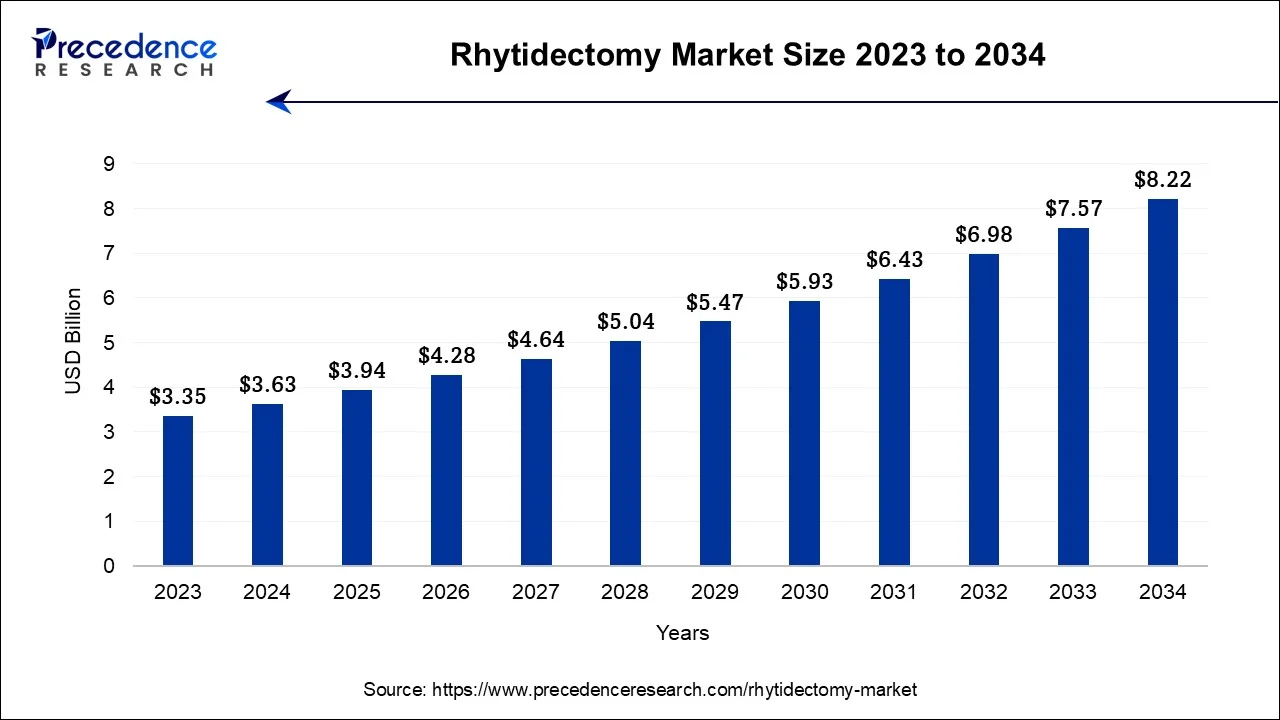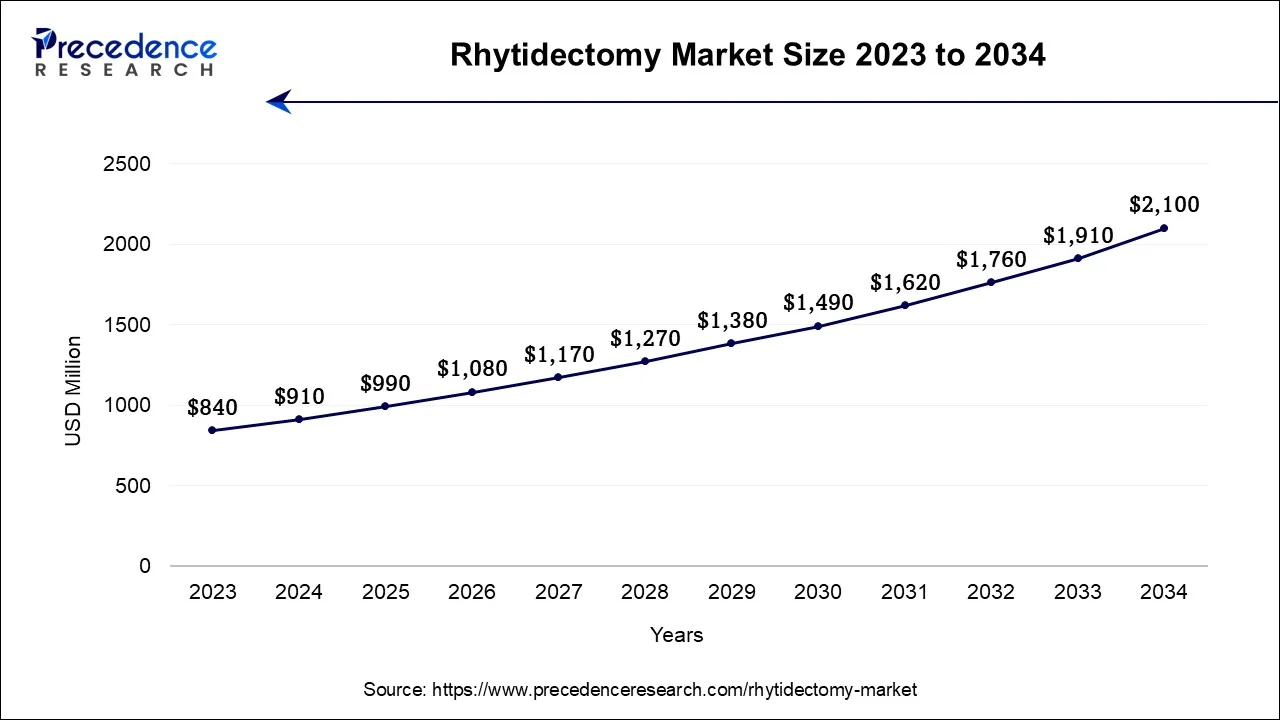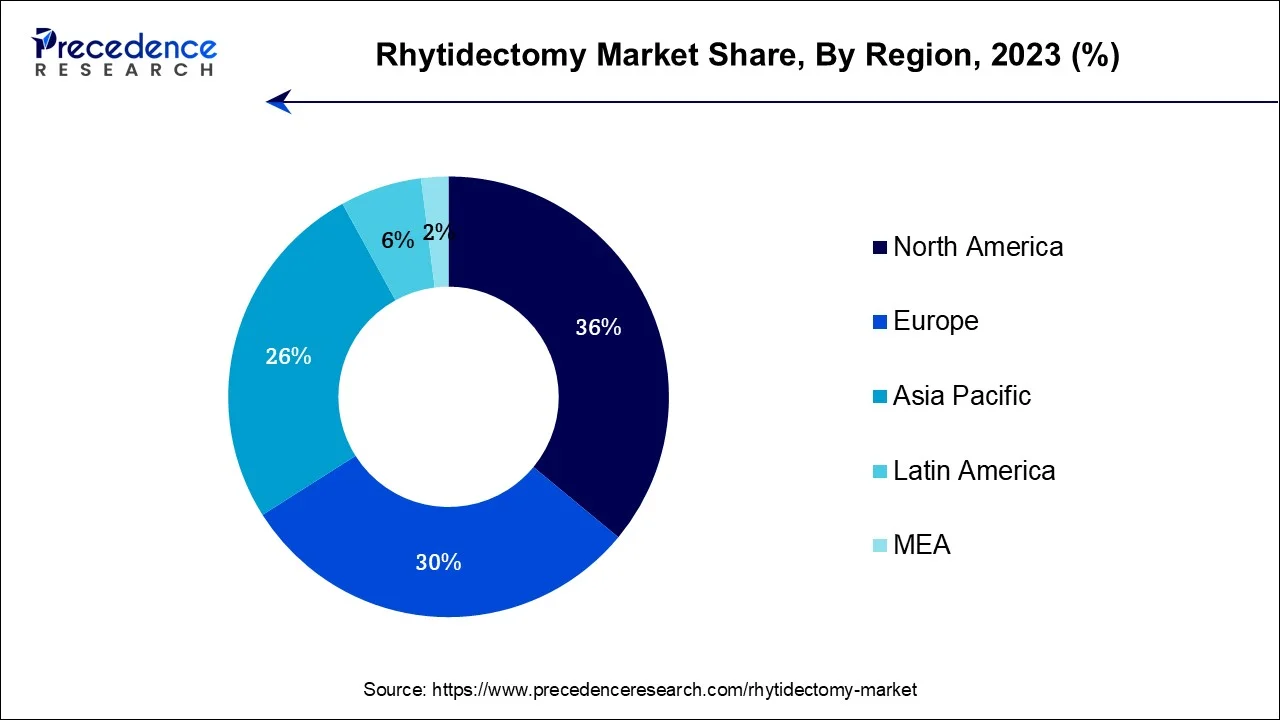Rhytidectomy Market Size and Forecast 2024 to 2034
The global rhytidectomy market size is estimated at USD 3.63 billion in 2024 and is anticipated to reach around USD 8.22 billion by 2034, representing a notele CAGR of 8.50% between 2024 and 2034.

Rhytidectomy Market Key Takeaways
- North America contributed more than 36% of revenue share in 2023.
- Asia-Pacific is estimated to expand at the fastest CAGR from 2024 to 2034.
- By Type, the full facelift segment has held the biggest revenue share of 82% in 2023.
- By Type, the mini-facelift segment is anticipated to grow at a remarkable CAGR of 10.8% during the projected period.
- By Age Group, the 55 - 69 years segment generated more than 59% of revenue share in 2023.
- By Age Group, the 40 - 54 Years segment is estimated to grow at the fastest CAGR over the projected period.
- By Gender, the female segment had the largest market share of 83% in 2023.
- By Gender, the male segment is anticipated to grow at the fastest CAGR over the projected period.
- By End Use, the hospital segment held the maximum revenue share of 42% in 2023.
- By End Use, the clinics segment is expanding at a noteworthy CAGR of 11.6% over the predicted period.
U.S. Rhytidectomy Market Size and Growth 2024 to 2034
The U.S. rhytidectomy market size accounted for USD 910 million in 2022 and is expected to be worth around USD 2,100 million by 2034, at a CAGR of 8.72% from 2024 to 2034.

North America has held the largest revenue share 36% in 2023. In North America, the rhytidectomy market is characterized by several prominent trends. The region has witnessed a growing preference for minimally invasive facelift procedures, aligning with the desire for quicker recovery and less downtime. Additionally, advanced technologies like 3D imaging and AI-assisted consultation tools have gained prominence, enhancing patient experiences and treatment planning. Rising awareness of facial aesthetics through social media and the influence of celebrity culture continue to drive demand. Ethical marketing practices and transparency in advertising are also emphasized to build patient trust and satisfaction in this competitive market.

Asia-Pacific is estimated to observe the fastest expansion In the Asia-Pacific region, the rhytidectomy market is witnessing several trends. Growing disposable incomes, changing beauty standards, and the influence of Western ideals are driving a surge in demand for facial rejuvenation procedures. Minimally invasive techniques, such as thread lifts and injectables, are gaining popularity due to their shorter downtime. Moreover, medical tourism is thriving, with individuals from neighboring countries seeking affordable and high-quality cosmetic surgery in key destinations like South Korea and Thailand. As Asia-Pacific embraces cosmetic enhancements, the rhytidectomy market continues to expand, offering a wide range of options to meet diverse patient preferences.
Rhytidectomy Market Growth Factors
The rhytidectomy market, centered around cosmetic and aesthetic facial rejuvenation procedures, experiences a dynamic landscape influenced by various industry trends, growth drivers, challenges, and opportunities. Rhytidectomy procedures have witnessed evolving trends. The market observes a growing demand for minimally invasive techniques like thread lifts and injectable fillers, driven by the desire for less downtime and lower risks.
Moreover, a shift towards natural-looking results has led to innovative approaches emphasizing subtle enhancements. Personalized treatment plans tailored to individual patient needs are gaining popularity. Additionally, the influence of social media and celebrity culture continues to impact patient preferences and expectations. Several factors contribute to the growth of the rhytidectomy market.
The aging global population seeks effective solutions to counteract the signs of aging, fueling demand for facelift procedures. Advances in surgical techniques, including endoscopic and deep-plane facelifts, offer improved results and safety, attracting more patients. The influence of digital marketing and online reviews plays a significant role in patient decision-making, driving practice visibility and growth. Furthermore, the growing societal acceptance of aesthetic procedures contributes to the market's expansion.
Despite its growth, the rhytidectomy market faces notable challenges. Rising competition among practitioners and clinics can lead to pricing pressures and concerns about treatment quality. Patients' unrealistic expectations, often fueled by edited images on social media, pose challenges in managing postoperative satisfaction. Ethical considerations related to the ethical marketing of aesthetic procedures are crucial, as maintaining transparency and patient safety remains paramount.
Addressing patient concerns about anesthesia risks, scarring, and recovery time requires careful communication and education. The rhytidectomy market presents opportunities for practitioners and industry stakeholders. Embracing innovative techniques and technologies, such as AI-assisted consultation tools and 3D imaging, can enhance patient experiences and outcomes. Tailoring marketing strategies to emphasize safety, personalized care, and natural-looking results can attract a discerning patient demographic.
Collaborations with complementary aesthetic providers, such as dermatologists and medspas, offer comprehensive treatment options. Expanding services to include postsurgical recovery and skincare can diversify revenue streams. Furthermore, staying informed about evolving patient demographics and their unique needs can guide practice growth and sustainability.
Market Scope
| Report Coverage | Details |
| Growth Rate from 2024 to 2034 | CAGR of 8.5% |
| Market Size in 2024 | USD 3.63 Billion |
| Market Size by 2034 | USD 8.22 Billion |
| Largest Market | North America |
| Base Year | 2023 |
| Forecast Period | 2024 to 2034 |
| Segments Covered | Type, Age Group, Gender, End Use, and Region |
| Regions Covered | North America, Europe, Asia-Pacific, Latin America, and Middle East & Africa |
Market Dynamics
Driver
Advancements in surgical techniques and influence of celebrity culture
Advancements in surgical techniques play a pivotal role in surging the market demand for the rhytidectomy market. Continuous innovation has led to safer and more effective facelift procedures, including minimally invasive and endoscopic techniques. These advancements offer patients reduced downtime, minimized scarring, and enhanced outcomes, attracting a broader demographic of individuals seeking facial rejuvenation.
As surgical procedures become less invasive and more precise, the appeal of facelifts grows, driving increased demand for these procedures as patients seek safer and more satisfying solutions for a youthful appearance. Moreover, the influence of celebrity culture significantly surges the market demand for the rhytidectomy market. Celebrities, with their youthful and rejuvenated appearances, set beauty standards and inspire individuals to seek similar transformations.
Patients aspire to emulate the age-defying results of their admired figures, driving an increased interest in facelift procedures. Celebrity endorsements and media coverage also contribute to greater awareness and acceptance of aesthetic surgeries. Consequently, the desire to achieve a youthful and glamorous look, inspired by celebrity role models, fuels the demand for rhytidectomy procedures.
Restraints
Surgical risks, downtime and recovery
Surgical risks, including anesthesia complications, scarring, infection, and postoperative issues, act as a restraint on the rhytidectomy market. Concerns about these potential risks can deter some individuals from seeking facelift procedures, impacting market demand. Patients may hesitate due to fears of complications, making it essential for practitioners to emphasize safety measures and communicate effectively about risk mitigation. Ensuring transparency and providing thorough preoperative consultations can help address these concerns and encourage individuals to consider rhytidectomy as a viable option for facial rejuvenation.
Moreover, Downtime and recovery associated with Rhytidectomy restrain market demand. The need for a postoperative recovery period, during which patients must limit activities and appearances may be temporarily altered, can be inconvenient for those with busy schedules. The prospect of downtime may discourage potential patients who are unable or unwilling to accommodate the recovery process. This restraint highlights the importance of patient education and options for less invasive or quicker recovery procedures in addressing the varying needs and lifestyles of potential facelift candidates.
Opportunities
Advanced technologies and targeted demographics
Advanced technologies surge market demand in the rhytidectomy market by enhancing patient experiences and outcomes. Innovations such as AI-assisted consultation tools and 3D imaging enable more accurate treatment planning, allowing patients to visualize potential results. Additionally, cutting-edge surgical techniques and materials, including endoscopic facelifts, reduce invasiveness and downtime. These technological advancements instill confidence in patients, attract a tech-savvy demographic, and offer safer and more personalized options, driving the increased interest and demand for facelift procedures.
Moreover, targeted demographics play a pivotal role in surging the market demand for the rhytidectomy market. Tailoring marketing strategies to different age groups and demographics allows practitioners to address the specific desires and concerns of diverse patient populations. This personalized approach enhances patient engagement and satisfaction by catering to their unique needs, ultimately driving increased demand for facelift procedures as individuals feel more understood and valued in their pursuit of youthful and rejuvenated appearances.
Impact of COVID-19
The COVID-19 pandemic had a notable impact on the rhytidectomy market. During the initial phases of the pandemic, many elective surgical procedures, including facelifts, were postponed or canceled to prioritize healthcare resources for COVID-19 patients. This led to a significant decline in surgical volumes and revenue for practitioners and clinics specializing in cosmetic procedures. Furthermore, patient concerns about the virus's transmission and the need for safety precautions led to a decrease in patient inquiries and appointments. Travel restrictions and lockdowns also hindered patients' ability to access healthcare facilities for consultation and surgery.
However, as the pandemic progressed, there was a noticeable rebound in demand for facelift procedures. The increased use of video conferencing and the "Zoom boom" placed a spotlight on facial aesthetics, driving individuals to seek rejuvenation treatments to improve their appearance on virtual platforms. Moreover, practitioners adopted strict safety protocols to mitigate infection risks, reassuring patients about their safety during surgical procedures. As vaccination efforts expanded, and the situation stabilized, the rhytidectomy market saw a resurgence in demand, reflecting the enduring interest in facial rejuvenation.
Type Insights
According to the Type, the full facelift segment has held 82% revenue share in 2023. A full facelift, also known as a traditional facelift, is a surgical cosmetic procedure in the rhytidectomy market. It involves the comprehensive rejuvenation of the face by addressing sagging skin, wrinkles, and muscle laxity across the entire facial area, including the neck. In recent trends, full facelift procedures have evolved to emphasize natural-looking results, focusing on subtle enhancements and improved techniques. Personalized treatment plans, advanced surgical methods, and shorter recovery times have become prominent, catering to the preferences of patients seeking comprehensive facial rejuvenation while minimizing downtime.
The mini-facelift segment is anticipated to expand at a significantly CAGR of 10.8% during the projected period. A mini-facelift, a type of rhytidectomy, is a less invasive facial rejuvenation procedure that targets specific areas of the face, typically the lower face and neck. It involves smaller incisions and shorter recovery times compared to traditional facelifts. In the rhytidectomy market, mini-facelifts have gained popularity due to their reduced downtime and lower cost. Patients seek subtle enhancements and quicker recovery. Surgeons are refining techniques to deliver natural-looking results, making mini-facelifts a prominent trend in facial rejuvenation procedures.
Age Group Insights
Based on the Age Group, the 55 - 69 years segment is anticipated to hold the largest market share of 59% in 2022. The 55 - 69 years age group in the rhytidectomy market represents individuals in their late middle age and early senior years. Trends indicate a growing interest in facelift procedures within this demographic. Many individuals in this age range seek rhytidectomy to address age-related facial sagging and wrinkles, with a desire for natural-looking results. Minimally invasive options are gaining popularity, aligning with their preferences for quicker recovery. Moreover, increased financial stability in this age group contributes to the steady demand for facelift procedures, as they prioritize self-confidence and maintaining a youthful appearance.
On the other hand, the 40 - 54 Years segment is projected to grow at the fastest rate over the projected period. Individuals aged 40 to 54 years represent a significant demographic in the rhytidectomy market. This age group typically seeks facelift procedures to address early signs of aging, including wrinkles and sagging skin. A notable trend is the preference for less invasive procedures like mini facelifts or injectable fillers, allowing for quicker recovery times.
Patients in this age bracket often prioritize natural-looking results to maintain a youthful appearance while avoiding an overdone look. With a focus on subtle enhancements, practitioners catering to this demographic emphasize personalized treatment plans and advanced techniques to meet their specific needs and expectations.
Gender Insights
In 2023, the female segment had the highest market share of 83% on the basis of gender. The rhytidectomy market, particularly for females, involves cosmetic procedures aimed at reducing the visible signs of aging. Women have traditionally been the primary demographic seeking facelifts, driven by societal beauty standards and a desire to maintain a youthful appearance. Current trends in the female rhytidectomy market focus on natural-looking results, personalized treatment plans, and minimally invasive options to address specific concerns. Women increasingly seek procedures that enhance their features without drastic changes, aligning with a broader trend towards subtlety and individualized aesthetics.
The male segment is anticipated to expand at the fastest rate over the projected period. The male segment in the rhytidectomy market refers to cosmetic facelift procedures specifically designed for men. Recent trends indicate a growing acceptance of facial rejuvenation among men, driven by a desire to maintain a youthful appearance and compete in a competitive job market. Men are increasingly seeking procedures like facelifts to address signs of aging, such as sagging skin and wrinkles.
The market is responding with specialized techniques tailored to male facial anatomy and the unique aesthetic goals of male patients, reflecting a shift toward greater inclusivity and gender diversity in cosmetic procedures.
End Use Insights
The hospital segment held the largest revenue share of 42% in 2023. In the rhytidectomy market, hospitals represent one of the primary end-use segments. Hospitals offer a controlled and sterile environment for facelift procedures, ensuring patient safety. A notable trend in this segment involves the integration of advanced surgical technologies and minimally invasive techniques to enhance patient outcomes while minimizing hospital stays.
Hospitals are increasingly focusing on comprehensive preoperative and postoperative care, providing patients with a seamless and supportive experience throughout their facelift journey. This trend aligns with the growing demand for safe, efficient, and patient-centric cosmetic surgery services within hospital settings.
The clinics segment is anticipated to grow at a significantly faster rate, registering a CAGR of 11.6% over the predicted period. In the rhytidectomy market, clinics are healthcare facilities that specialize in offering cosmetic and aesthetic surgical procedures, including facelifts. These clinics cater to individuals seeking facial rejuvenation to address signs of aging. Trends in clinic-based rhytidectomy services include the adoption of minimally invasive techniques, personalized treatment plans, and the integration of advanced technologies like 3D imaging for precise surgical planning. Clinics also emphasize safety protocols, patient education, and ethical marketing practices to build trust among their clientele, ultimately driving demand for their services.
Rhytidectomy Market Companies
- Allergan, Inc.
- Merz GmbH & Co. KGaA
- Galderma S.A.
- Cynosure, Inc.
- Alma Lasers Ltd.
- Cutera, Inc.
- Lumenis Ltd.
- Solta Medical, Inc.
- Syneron Medical Ltd.
- Ulthera, Inc.
- Suneva Medical, Inc.
- Sciton, Inc.
- AQTIS Medical
- ThermiGen, LLC
- Quanta System S.p.A.
Recent Developments
- In 2021, Allergan Aesthetics has entered into a warrant agreement with Cypris Medical, granting the option to acquire the company, along with its Xact device, following the completion of a clinical trial initiated in 2021. This strategic move aims to expand Allergan Aesthetics' medical device offerings.
- In 2017, Allergan successfully completed its acquisition of ZELTIQ Aesthetics, enhancing its portfolio with a leading body contouring business. This addition complements Allergan's renowned offerings in facial aesthetics, plastic surgery, and regenerative medicine, strengthening its position in the aesthetics market.
Segments Covered in the Report
By Type
- Full Facelift
- Mini Facelift
By Age Group
- 30 - 39 Years
- 40 - 54 Years
- 55 - 69 Years
- 70 Years and Above
By Gender
- Male
- Female
By End Use
- Hospitals
- Clinics
- Others
By Geography
- North America
- Europe
- Asia-Pacific
- Latin America
- Middle East and Africa
For inquiries regarding discounts, bulk purchases, or customization requests, please contact us at sales@precedenceresearch.com
Frequently Asked Questions
Ask For Sample
No cookie-cutter, only authentic analysis – take the 1st step to become a Precedence Research client
 sales@precedenceresearch.com
sales@precedenceresearch.com
 +1 804-441-9344
+1 804-441-9344